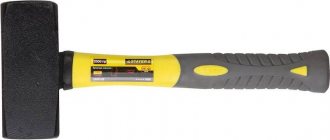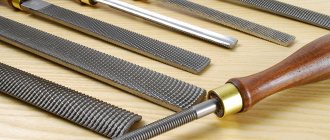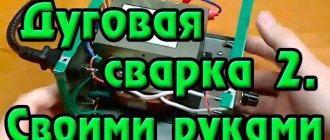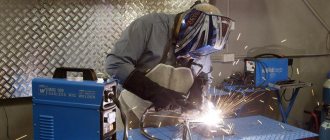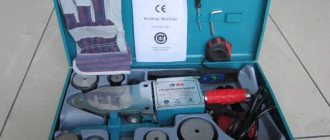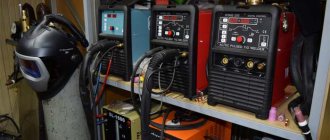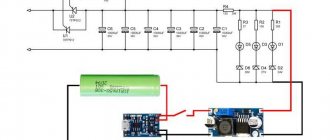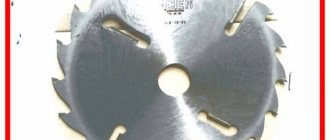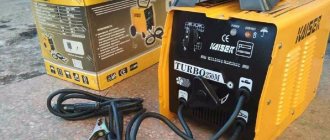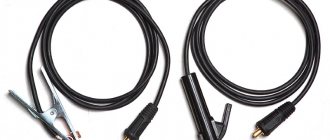Welding wire is the most important consumable material used when welding in manual, automatic or semi-automatic modes. The additive is a metal product wound on a reel.
In most cases, the welding additive is used for the manufacture of flexible electrodes or is used as a filler material, providing a high-quality seam and reliable connection of metal parts.
Semi-automatic welding using filler wire requires the use of a shielding gas atmosphere.
Types of wire for semi-automatic machines
The selection of welding wire for semi-automatic machines should be carried out for a specific type of metal being joined. The use of filler consumables significantly improves the quality of the seam and prevents the formation of pores and irregularities in the joint.
The main advantages of using an additive when performing welding work are presented:
- acceleration of the welding process;
- ease of use in industrial applications;
- a significant reduction in the likelihood of defects due to the lack of additive coating;
- a large selection of consumables, allowing you to select the optimal additive for each specific case;
- low level of slag formation during welding.
Disadvantages of using a filler component in welding:
- the need for constant protection;
- difficulty in storing large skeins;
- difficulty in selecting the optimal diameter of the additive;
- the need to constantly use flux.
Wire grades table.
All types of wire for welding are usually divided into:
- Copper-plated. This type of wire is used for welding carbon and low-alloy steel parts. Copper-plated steel filler components provide high-quality welds and are characterized by a low metal spatter coefficient.
- Powder. Additive components of such grades are made in the form of a hollow tube made of low-carbon steel. Inside the container there are deoxidizers and slag-forming substances, which ensure comfortable use of semi-automatic welding without shielding gas. Flux cored filler wires help to significantly reduce slag formation and reduce weld processing time.
- Solid section. This type of wire differs from ordinary wire in that welding electrodes are made from it.
- Non-copper-plated. Additives of this type are used primarily for working with products made of low-carbon steel.
- Activated. Powder additives used during welding in a carbon dioxide atmosphere.
- Gas welding. To work with carbon and low-carbon grades of steel, it is best to use gas welding filler components.
- Aluminum. One of the few types of wires suitable for welding aluminum parts. When working with aluminum filler, low porosity of welds is observed. Such additives are actively used in the shipbuilding and dairy industries.
- Made from stainless steel. The filler component allows you to weld stainless steel products and prevent corrosion of the resulting weld.
- Flux. This type of filler wire is widely used for joining medium carbon, low carbon and carbon steels. Due to the presence of a built-in flux, such additives can be used when welding without shielding gas.
- Alloyed. One of the best components that allows welding work in any gas mixtures and with any types of metals.
Aluminum wire
Used for semi-automatic welding of metal and aluminum structures. Aluminum welding wire contains an alloy of the same name, which determines the following properties of the weld:
- high degree of strength;
- repeatability of weld shade;
- high resistance to corrosion.
Often such products are used in mechanical engineering and shipbuilding, as well as in other areas where interaction of products with water is expected. This material is lightweight and flexible. Used for joining parts made of aluminum and stainless steel.
Classification and labeling
Before choosing the type of filler component, you should clearly understand what materials will be welded. There are several groups of wires that contain alloying elements.
This classification includes:
- additives containing a small amount of carbon;
- filler materials containing a small amount of alloying metals;
- high alloy additives.
The marking of welding wire depends, first of all, on the grade of steel being welded and the atmosphere in which the work will be carried out.
Steel filler wire is one of the most popular and in demand.
Filler rods for welding.
In accordance with the state standard, depending on the diameter, welding wire is divided into:
- Diameter from 0.3 to 1.6 millimeters. Copper-plated wire with this cross-section is used when welding metal parts with a semi-automatic welding machine in a protective atmosphere.
- Diameter from 1.6 to 12 millimeters. A similar type of filler material can be used to create welding electrodes.
- Diameter from 2 to 6 millimeters. This type of wire is used during welding with flux.
The marking number of the additive material is necessary to indicate the composition of the additive.
In accordance with the state standard, the wire additive is marked as follows:
- the first numbers are the diameters in millimeters;
- the letters following the numbers are the purpose of the additive;
- the further indicator shows the carbon content in fractions of a percent;
- the fourth block of designations is an indicator of alloying components;
- the fifth block carries information about the use of the additive, for example, the letter E means for the electrode, and the welding additive is indicated by the letter O.
For example, a wire additive, marked as 3SV-08A-0-Sh GOST 2247-70, is deciphered as follows: 3 is a diameter of 3 millimeters, SV is a welding wire, 08A is 0.08% carbon, 0 is a copper-plated additive, Ш is electroslag remelting and GOST 2246-70 is the designation of the state standard to which this consumable material corresponds.
Chemical composition for welding steel
The steel welding additive guarantees good mechanical properties of the weld. The main grades of wire filler used for welding carbon steels are shown in the table below:
| Filler wire marking | ||
| Protection: nitrogen and helium | Protection: CO2 | |
| 20ХГСА | Sv-15KhMA, Sv-18KhGSa | Sv-08G2S |
| 30ХГСА | Sv-15KhMA, Sv-18KhGSa | Sv-10GSM, Sv-10GSMT, Sv-08Ch2SMA |
| 12ХМ | Sv-08ХМ | Sv-10ХГ2СМА |
| 15ХМ | Sv-08ХМ | Sv-08HNSMA, Sv-08HG2SM |
| 12Х1МФ | Sv-08HMFA | Sv-08KhGSMFA |
| 15Х1МФ | Sv-08ХМ | Sv-08H1M1GSF |
| 15Х5М, 15Х5, 15Х5ВФ | Sv-10Х5М, Sv-08G2S | Sv-08G2S |
According to the state standard, filler wires for welding stainless steel and ordinary steel are divided into:
- carbon, intended for joining products made of low and medium carbon steels;
- alloyed, for welding low-alloy and heat-resistant metals;
- high-alloy, used when working with chromium-nickel, stainless or other alloy steels.
Filler materials for stainless steel are chromium or nickel-containing steels.
The main advantages of specialized welding additives designed for joining stainless steel products are:
- high quality weld;
- homogeneity and absence of pores in the connection;
- corrosion resistance;
- minimum metal spatter coefficient;
- stable burning of the electric arc during operation.
When trying to calculate the additive consumption for a weld, it should be taken into account that the additive for stainless steel has an increased resource.
Consumables used when working with high-alloy or stainless steels are divided into two types:
- powder;
- solid.
Argon welding method.
Powder additives allow welding to be carried out without the use of shielding gases. In the simplest case, the powder additive is a hollow tube with flux inside.
During operation, flux and filler elements form a cloud of gas, which contributes to high-quality weld welding. Such wires can be used in conditions of insufficient space, since a welding machine without a gas cylinder can reach even the most inaccessible places.
Solid wires are ordinary additives intended for welding in shielding gases, for example, Argon or carbon dioxide.
It is worth noting that filler elements used for welding stainless steel are divided into classes:
- normal accuracy;
- increased accuracy with marking P.
The most commonly used types of filler materials for welding stainless steel products are:
- Sv06Х20Н11М3.
- Sv01Х18Н10.
- Sv01Х19Н9.
When decrypting, remember that:
- A stands for nitrogen;
- B – niobium;
- B is tungsten;
- D – copper;
- M – molybdenum;
- C is silicon;
- T – titanium;
- X – chromium;
- N – nickel;
- Yu – aluminum;
- F – vanadium;
- C – zirconium.
Types of welding wire
There are three types of welding wire: solid wire, flux-cored wire (also called flux-cored wire), and activated wire. Let's take a closer look at each type.
Solid wire or solid wire is made from pure metal. There are no impurities or additional substances in it. This is the simplest type of wire and the most common. It is often used when welding in a shielding gas environment.
Flux-cored wire, also known as wire for welding without gas. Based on the name, it is clear that such wire is used for welding without shielding gas. But how is this effect achieved? After all, welding without gas entails a deterioration in the quality of welding and generally complicates the work process.
It's simple: flux-cored wire has a special hollow design. In appearance it looks like an ordinary solid wire, but inside it is hollow. And this cavity contains special powder substances that act as flux and replace gas. This wire is used in cases where it is not possible to deliver a gas cylinder to the welding site. For example, at altitude.
Now about the activated wire. Activated wire is the most interesting type. It combines solid wire and cored wire. How is this possible? The fact is that this wire takes all the best from the previous two types. It borrowed its design from solid wire and its protective properties from powder wire. Only, unlike flux-cored wire, in this wire the protective impurities are not poured into the cavity, but are evenly distributed throughout the “body” of the wire.
Manufacturers of welding wire products
The main brands of welding wire are produced by the following manufacturers:
- SvarMontazhStroy. One of the most famous Russian production facilities, specializing in the production of filler wire of various brands for all types of welding. Modern equipment and the use of European manufacturing technologies allow the company to produce products that meet the highest quality standards.
- LLC Petromet. The enterprise, which belongs to the Leningrad plant, produces wire grades Sv01Х18Н10, Sv-15ХМА and others.
- Weld-Metiz LLC.
- OJSC Volgograd Steel Wire Rope Plant. Stainless steel wire produced by the steel wire rope plant meets state standards and can be used when performing welding work with a semi-automatic device.
- OJSC West Siberian Metallurgical Plant.
Table of types of welding wire.
Filler materials for semiautomatic welding machines produced by these enterprises are divided into 77 varieties. Many manufacturers coat the welding filler wire with copper, which produces a better weld and reduces molten metal droplet spatter.
How to choose wire?
The welding wire is used during welding. The use of filler material allows you to fill the weld seam formed during the connection of metal products.
In other words, the use of filler wire makes it possible to compensate for metal losses resulting from spattering. Experts note that in addition to wire, filler materials in the form of rods and tapes can be used.
Content of components in welding wire.
There are two main rules when choosing welding wire:
- The material from which the additive is made must have the same composition as the products being welded. Before moving on to choosing an additive material, you should study the composition of the products and select an additive with the most similar composition. Harmful materials that cause increased consumption of welding wire are sulfur and phosphorus.
- The melting point of the filler material should be slightly lower than that of the products being welded. Welding work performed using filler wire with a melting point higher than that of the metal of the part can lead to burnout of the product. Before joining the metal, it is necessary to select a wire that melts evenly. This approach will allow you to obtain a durable seam without slagging or cavities.
The best grade of wire must meet the following requirements:
- the diameter of the filler should be similar to the thickness of the metal being welded;
- the wire additive must not contain rust, paint or any other contaminants that affect the chemical composition;
- the additive used in welding must be adjusted evenly;
- the seam obtained as a result of welding work should not contain scale, slag, cracks and pores.
It is necessary to select an additive component depending on the metal of the products being connected.
Filler wire for steel welding
To connect steel parts, it is best to use a copper-plated additive, for example, grade SV-08G2S. This option is ideal for welding work on pipelines, boilers and containers under high pressure.
In addition, this brand of filler material is excellent for working with thin sheet steel. Several more optimal types of filler components for welding steel structures are shown in the table:
| Wire grade | Shielding gas used | Use temperature | Special marks |
| Sv-08GS, Sv-08GSMT | Carbon dioxide | -40 to +475 | None |
| Sv-08G2SNTYUR | Carbon dioxide | -70 to +475 | Does not require further seam processing |
| Sv-08G2S | Argon, Argon + Carbon dioxide | -70 to +475 | Does not require further seam processing |
| Sv-08GSMT | Carbon dioxide, Argon or mixture | -40 to +350 | For connecting products made of steel type 15G2SF |
| Sv-10X5M | Carbon dioxide, Argon or mixture | 0 to +600 | The work is carried out with preheating of the products to +300 degrees and subsequent tempering at 750 degrees for three hours. |
| SV-04Х19Н11М3 | Argon or a mixture of Argon + Carbon dioxide | -70 to +350 | For products that do not require resistance to intergranular corrosion. |
| Sv-01Х17Н14М | Argon or a mixture of Argon + Carbon dioxide | -70 to +350 | Suitable for structures that require increased resistance to intergranular corrosion. |
Almost all of the above wires have a similar consumption when welding with semi-automatic welding. It is necessary to select a filler component for connecting steel products based on the requirements for the resulting weld.
Wire for welding aluminum
For welding aluminum products, a wire filler is used, consisting of either pure aluminum or aluminum with the addition of magnesium and silicon.
In most cases, additives used to join aluminum parts are divided into:
- pure aluminum, with an Al content of 99%;
- aluminum-silicon, with a ratio of 95% and 5%, respectively;
- aluminum-magnesium, with a metal ratio of 94% and 6%, respectively.
The main brands of filler components used when joining aluminum are shown in the table below:
| Wire grade | Shielding gas used | Domestic analogue |
| OK Autrod 1070 The additive is used for welding pure aluminum and ductile alloys. Characterized by excellent resistance to chemical attack. | Argon | St.-A97, St.-A85, St.-Amts. |
| OK Autrod 4043 Widely used for welding alloys such as AD31, AD33, AD35 | Argon | St.-AK5, St.-AK6 |
| OK Autrod 1450 Chemical and environmental resistant wire provides a fine-grained weld. | Argon | St.-1201 |
| OK Autrod 5356 This grade of material is regularly used for welding metal structural profiles made of aluminum and manganese. | Argon | St.-Amg 3 |
| OK Autrod 5183 This type of filler wire is used for welding non-hardenable aluminum alloys. | Argon | St.-AMg 5 |
Filler material for joining stainless steel products
When welding stainless steel, the use of shielding gas is mandatory. As a rule, the additive components include silicon and carbon. The silicon component of the additive makes it possible to obtain a high-quality and durable weld; carbon is necessary to prevent the formation of intergranular corrosion.
Some brands of stainless steel welding additives may contain chromium and nickel. These elements make the filler material more durable and resistant to corrosion.
The main brands of wire for connecting stainless steel products are:
| Wire grade | Shielding gas used | Domestic analogue | Chemical composition |
| OK Autrod 347 Si Used for joining stainless steel grades 08Х18Н10, 12Х18Н9Т, 08Х18Н10Т and similar. Thanks to niobium and silicon, the filler component ensures excellent weld quality and prevents the formation of intergranular corrosion. | Argon | St.-06Х21Н7БТ, St.-06Х19Н9Т, St.-01Х18Н10, St.-01Х19Н9. | Carbon <0.08, Silicon 0.8, Manganese 1.7, Chromium 20.0, Nickel 10.0, Niobium 0.6 |
| OK Autrod 308LSi Filler wire is widely used for welding austenitic stainless steels. Widely used in food, petrochemical and other industries. | Argon | St.-06Х19Н9Т, St.-01Х18Н10, St.-01Х19Н9. | Carbon <0.03, Silicon 0.8, Manganese 1.7, Chromium 20.0, Nickel 10.0 |
| OK Autrod 318 Si Wire for welding steels containing chromium, nickel and molybdenum. Thanks to niobium, high resistance against intercrystalline corrosion is ensured. Due to the presence of silicon in the composition, the additive ensures high quality welds. | Argon | St.-08Х19Н10М3Б, St.-06Х20Н11М3ТБ | Carbon <0.08, Silicon 0.8, Manganese 1.7, Chromium 19.0, Nickel 12.5, Niobium 0.6, Molybdenum 2.7 |
Copper welding wire
Copper products are common in industry due to the incredible properties of this metal to effectively resist corrosion even in the most unfavorable environments.
Due to the fact that the seams obtained as a result of welding operations must have good physical properties, including thermal conductivity, electrical conductivity, corrosion resistance and density, increased demands are placed on the wire filler.
The most optimal types of filler material for copper welding are:
| Brand and description of wire | Shielding gas used |
| OK Autrod 19.12 Wire of this brand is actively used for welding copper products and parts made of low-alloy copper alloys. | Argon |
| OK Autrod 19.30 Used when joining products made of bronze or low-alloy copper. This type of filler material is widely used in the automotive industry, as it contributes to the formation of a high-quality seam when connecting copper to cast iron. | Argon or Argon + 1% oxygen |
| OK Autrod 19.40 Used for welding castings and rolled aluminum bronzes. Can also be used to connect copper pipes. | Argon |
Most copper welding filler materials are supplied wound on plastic cartridges. Standard wire thickness is 0.6, 08 or 1 millimeter. When welding copper products, a flux containing borax, sodium chloride and boric acid should be used.
Connecting parts made of cast iron and nickel
Welding of nickel products is carried out using filler wire containing manganese, silicon, magnesium and titanium. The manganese component promotes the binding of sulfur, silicon is necessary to increase the fluidity of the metal, magnesium is needed for the final binding of sulfur particles.
The diameter of the filler wire for welding nickel products should be equal to half the thickness of the part.
To weld cast iron parts, special attention must be paid to the choice of additive. The fact is that the use of conventional copper-plated additives when welding cast iron leads to the appearance of cracks in the weld. That is why it is recommended to use filler elements containing non-ferrous alloys to connect cast iron products.
The optimal additives for welding products made of cast iron and nickel are shown in the table:
| Brand and description of wire | Shielding gas used |
| OK Autrod 19.82 Nickel-based filler wire is ideal for joining nickel, high-alloy steel and cast iron. In most cases, it is used for welding tanks, pipelines and structures in the chemical industry. | Argon |
| OK Autrod 19.85 Used when welding parts made of nickel or heat-resistant steels. Excellent for joining products made of dissimilar metals. | Argon |
| OK Autrod 15.66 Well suited for welding cast iron parts. It is used for welding work related to pumps, shut-off valves and heavy sections of machines. | Argon or Argon +2% oxygen |
Flux filler wire
Flux-cored filler wire is widely used for welding low-alloy and carbon steels.
Welding wire material.
The key advantages of powder additive are:
- ability to follow the arc;
- ideal weld composition;
- welding work can be carried out in any position;
- the equipment can be used even in the most inaccessible places, due to the absence of the need for equipment for supplying gas and flux;
- counteraction to the mechanical pressure of welding beads, thanks to the use of a special lubricant in the additive.
Depending on the type of filler, powder additive components are divided into:
- rutile for welding medium-carbon steels;
- rutile-fluorite, used in the welding of low-alloy steels;
- fluorite-carbonate, used in welding low-carbon and low-alloy steel structures;
- fluorite, suitable for welding low-alloy steel products;
- organic rutile, used in welding low-carbon steels.
Experienced welders recommend using Esab universal cored wire, which provides high mechanical properties of the weld between most metals. This additive is not a powder additive, however, it contains flux inside it, which ensures good welding quality.
Tools
0 votes
+
Vote for!
—
Vote against!
In everyday life, welding work is not often required, unlike in the industrial sector, where welding is an integral part of the process. However, when the need arises to cook something, the question also arises of how to do it, using what unit, what consumables are needed. The choice of welding method and consumables directly depends on what materials need to be welded together. For example, to weld refractory and non-ferrous metals, you have to use welding wire, but not just what kind, but a different type is selected for each case. Often the question of how to choose a wire for welding confuses a novice welder or a craftsman who has recently used the machine. In this article we will talk about what kind of welding wire there is and how to select it for certain cases.
- Welding wire marking
- Types of welding wire
- Welding filler wire
- Flux Cored Wire for Welding
- Steel Welding Wire
- Aluminum Welding Wire
- Wire for welding stainless steel
- Copper Welding Wire
- Wire for welding cast iron and nickel alloys
- Titanium Welding Wire
- Welding wire diameter
Welding wire marking
For welding wire, the most important thing is the chemical composition; it is this that determines the choice. You can recognize it by reading the markings on a domestically produced product, which complies with GOST 2246-70 , or foreign markings according to AWS .
Since the production of welding wire in the CIS countries is very well established, we will first look at the designations on domestically produced products. First, let's decipher the letter designations:
Example: SV-08G2S means
- SV – welded wire;
- 08 – mass fraction of alloyed elements in the wire composition. In this case, the wire contains 0.08% carbon;
- G – contains manganese;
- 2 – no more than 2% of the element indicated before the number. In this case, no more than 2% manganese;
- C – contains silicon. In this case, there is no number after the designation “C”, this means that the silicon content is less than 1%, but more than 0.5%.
Example: SV-06Х21Н7БТ means Welding wire, which contains 0.06% carbon, 21% chromium, 7% nickel, alloyed with niobium and titanium.
Example: SV-08Х19Н10МЗБ means Welded wire, which contains 0.08% carbon, 19% chromium, 10% nickel, 3% molybdenum, alloyed with niobium.
Sometimes in markings according to modern standards, aluminum is designated by the letter “A”.
Example: SV-A97 is a welding wire consisting of 99.97% aluminum.
Example: SV-AK5 is a welding wire consisting of 95% aluminum and 5% silicon.
To order a particular wire, you must accurately indicate the marking. Unfortunately, international standards are not as easy to read as GOST standards, so if you haven’t found the required domestically produced wire, contact a specialist so that he can select a foreign analogue for you.
Types of welding wire
In total, there are about 77 brands of domestically produced welded wire, which can be divided into 3 main categories:
Thus, the wire is divided according to the area of application: one is used for low-alloy steels, the other for carbon steels, and the third for welding non-ferrous metals or submerged arc welding.
For example, the SV-08G2S wire considered above is alloyed, since it contains more than 2.5% alloying metals: 2% manganese and more than 0.5% silicon.
Welding filler wire
Welding wire is a so-called filler material. In the process of welding two elements, the wire is brought to the seam and melts along with the edges of the metals, filling the seam. Thus, the filler wire serves as a material that makes up for losses due to metal spatter during welding. In addition to wire, filler rods and tapes can be used as filler material.
The main requirement when choosing a filler wire is that it must have the same chemical composition as possible as that of the materials being welded . For example, you need to pay attention to the carbon content. The plasticity of the seam depends on the amount of this element. Sulfur and phosphorus are considered negative impurities. To ensure a high-quality, reliable weld and long service life of the product, the composition of the filler wire should be as close as possible to the composition of the metals being welded.
The second requirement is that the melting temperature of the filler wire should be slightly lower or the same as that of the metals being welded . Pay attention to when the wire begins to melt; if this happens later than the metals being welded, then there is an extremely high probability that the metal on the elements being welded will burn through. And of course, it is important that the melting occurs evenly, then the seam will be neat (without defects) and more durable. If the melting temperature is chosen incorrectly, this threatens the appearance of cracks in the weld, high slagging of the seam, spattering of the metal edges, and, worst of all, the presence of hidden cavities inside the weld.
General requirements for filler wire:
- The thickness of the filler wire must correspond to the thickness of the elements being welded.
- The wire must be clean, free of scale, rust, traces of oil or paint, or other contaminants.
- The wire should melt evenly without spattering.
- The resulting weld should be smooth, without cracks or pores in the metal.
Most often, filler wire is used when welding in a shielding gas environment, which provides a clean and reliable weld, protecting the weld pool from oxygen. Argon, helium, carbon dioxide or mixtures of argon and carbon dioxide can be used as shielding gases.
Wire for argon arc welding of non-ferrous metals should have a similar composition. For example, for welding aluminum, wire SV-97, SV-A85, SV-AMts or its foreign analogues ER 1100 (OK Autrod 1070 (OK Autrod 18.01)) is used. These materials are resistant to chemical and atmospheric influences; two weldings are used for products made of pure aluminum or its ductile alloys (AD1, AMts).
Wire for semi-automatic welding of low-alloy steels is the market leader in welding consumables, since the vast majority of steel products belong to this category. The most common filler wire is the already known SV-08G2S, which is produced both in the usual version - without coating, and copper-plated - with anti-corrosion protection. The use of wire with anti-corrosion copper-plated protection makes the product of higher quality, the arc burns more steadily during the welding process, and the copper tip is consumed more slowly.
The filler wire welding process uses flux. Substances called “fluxes” make it possible to make the structure of the weld as ideal as possible, thereby protecting the metal in the weld area from premature destruction. Thanks to fluxes, the surface of the metal in the welding zone is even and smooth, and the degree of extensibility of the metal in the weld zone is high. All this makes the product more reliable and durable.
The following are used as flux:
- Boric acid.
- Borax.
- Silicon oxides.
- Sulfur.
Most often, filler wire is sold in coils. Before use, it must be straightened and cut into pieces of the required length. If the wire will not be used for a long time, it must be protected by wrapping the coil with special waterproof paper.
Flux Cored Wire for Welding
To improve the welding process in field conditions or open spaces, so-called flux-cored wire is used. This makes it possible to make high-quality seams, while spending less time and effort on mechanizing the process and cleaning the material from splashes. This type of wire is divided into two subtypes: gas-shielding flux-cored wire and self-shielding flux-cored wire.
Flux-cored gas shielding wire is intended for semi-automatic and automatic welding of low-alloy and carbon steels in a protective gas environment: carbon dioxide or its mixtures with argon.
Due to its high penetration, this wire can be used for welding fillet, lap and butt joints in almost one pass. The advantages of flux cored gas shielding wire are low level of spattering, slag crust is easily separated, high resistance to porosity and unwanted slag inclusions, stable jet transfer.
Flux cored gas shielding wires are divided into the following types:
New types of such wire make it possible to achieve an ideal weld shape, low spatter, high weld speed, high deposition rate and low smoke if used for welding in protective mixtures with a high content of argon.
Flux cored self-shielding wire is also called flux-cored wire or simply self-shielding. Its core contains all the necessary slag-forming, protective and deoxidizing additives. As a result, there is no need to use bottled gas. This greatly simplifies the task, since there are many problems and dangers associated with the use of gas. Cored wire allows you to avoid a number of hassles with storing, certifying gas cylinders, refilling them and moving them from place to place.
If during conventional semi-automatic welding a protective pool was formed using a gas flow that came out of the torch nozzle, then wire for welding without gas allows you to create protection in a different way - during the welding process, the flux located in the wire core evaporates and forms a protective bubble directly at the welding site . It cannot be washed off by a stream of air, so such wires are used for welding outdoors in strong winds.
Advantages of cored self-shielding wire:
- Open arc. This allows the operator to monitor what is happening and redirect the deposited metal.
- Guaranteed perfect seam composition.
- You can weld in any position.
- The equipment is compact, there is no need to use gas cylinders, as well as equipment for supplying gas and flux.
- A special coating of the wire with lubricant makes it possible to withstand the mechanical pressure of the rollers that feed the material into the welding zone.
For open arc surfacing, wires with a diameter of 2.0 – 3.0 mm are used, and for submerged arc surfacing, wires with a diameter of 3.6 mm are used. For welding large-sized products, wire with a diameter of 5.0 mm is used.
The welding technology using self-shielding wire does not differ from the technology using solid welding filler wire. The only limitation is that the semi-automatic welding machine must have a No Gas mode.
Steel Welding Wire
Copper-plated wire SV-08G2S is used for welding pipelines, boilers, structural steel products, as well as containers that will be under high pressure during operation. It has also proven itself well when working with thin metal and welding in any position. The tensile strength of this wire is in the range of 900 – 1350 MPa.
The table below shows the grades of welding wire that can be used for welding steel under gas protection conditions - argon, carbon dioxide or a mixture of these gases.
Table 1. Wire for welding steel in shielding gases.
Aluminum Welding Wire
For welding aluminum and its alloys, wire is used consisting of pure aluminum or with the addition of magnesium and silicon, depending on the composition of the alloy being welded. Most often, products are made of aluminum (99%), aluminum-magnesium alloy (4.8 - 6% magnesium and the rest aluminum) and aluminum-silicon alloy (95% aluminum and 5% silicon). For each of them, its own wire is selected, this can be easily seen from the table.
Wire for argon welding of aluminum is used with flux, which can have the following composition: potassium chloride 27 - 33%, lithium chloride 9 - 12%, sodium chloride 42 - 48%, potassium fluoride 12 - 16%.
Table 2. Wire for welding aluminum and its alloys.
Welding of aluminum parts is common in the food industry.
Wire for welding stainless steel
Welding of products made of stainless steel or heat-resistant alloys is carried out using a semi-automatic machine using shielding gas. The welding wire is made of high-alloy heat-resistant steel. Stainless steel welding wire contains silicon and carbon. Silicon ensures the strength of the weld and its quality. Carbon prevents the formation of intercrystalline corrosion.
In addition to silicon and carbon, stainless steel wire may contain chromium and nickel. This wire is more resistant to corrosion. It is used in mechanical engineering, food and light industry, oil industry and shipbuilding.
Table 3. Stainless steel welding wire for welding stainless and heat-resistant steels.
Copper Welding Wire
The use of copper in industry and power engineering is associated with the exceptional properties of copper to resist corrosion in aggressive environments. The purer the metal composition, i.e. The more copper it contains and the fewer impurities, the higher the corrosion resistance. This is why increased demands are placed on copper-based materials and filler wires.
Depending on the amount of impurities, the following grades of copper are distinguished:
Due to the fact that the welds of products made of pure copper must retain the entire complex of physical properties for which this metal is used - thermal conductivity, electrical conductivity, corrosion resistance and density, extremely stringent requirements are imposed on welding wire. And during the welding process, the seam should not become contaminated with impurities.
Welding wire for copper is made of electrolytic copper, and during the welding process a flux of borax 48 - 53%, sodium chloride 32 - 38%, boric acid 10 - 14% can be used.
Table 4. Wire for copper welding.
Wire for welding cast iron and nickel alloys
For welding nickel, wire alloyed with metals such as manganese (no more than 2%), silicon (no more than 0.8%), magnesium (no more than 0.3%) and titanium (no more than 0.1%) is well suited. Manganese is necessary for deoxidation and binding of sulfur, silicon makes the metal more fluid, magnesium binds those sulfur residues that remain after manganese. It is advisable to choose the diameter of the wire for welding nickel equal to half the thickness of the metal of the products being welded.
Cast iron is a difficult metal to weld, since there is a high probability of cracks appearing in the weld. The way out of the situation was to use wires coated with non-ferrous alloys for welding, or preheat the workpieces before welding and use flux-cored wires.
Table 5. Wire for welding cast iron and nickel alloys.
Titanium Welding Wire
To weld titanium, cold-drawn sheet metal wire is used. The composition should be as close as possible to the composition of the base material. Most often this is filler flux-cored wire of the PPT-1 and PPT-3 brands. The titanium welding technology itself involves the use of argon arc welding and a non-consumable tungsten electrode. Wire consumption is 1.2 - 1.5 m per linear meter of seam.
Welding wire diameter
The diameter of the filler wire is selected depending on the thickness of the metal in the workpieces being welded. So if the thickness of the product is 3 - 5 mm, then take a wire of 2 mm, if the thickness is 5 - 16 mm, then use a wire with a diameter of 3 - 4 mm. For thicker sheets 7 - 25 mm, you can use 7 mm thick wire.
For semi-automatic welding machines, wire is produced in the following diameters: 0.6 mm, 0.8 mm, 1 mm, 1.2 mm, 1.6 mm.
Wire for welding with electrodes and filler rods – 1.6 – 5 mm.
The widest range of welding wires in the flux-cored wire category is 0.6 - 6 mm.
In addition to the thickness of the product, the required diameter of the welding wire is also influenced by the current required for welding in a particular case. You can see what wire diameters are needed in a particular case in the table below.
Table 6. Welding wire diameter depending on current strength.
Selecting a welding wire is a very important task. If the tables provided still did not help you understand the question of which wire to use, then it is better to seek help from a specialist.

